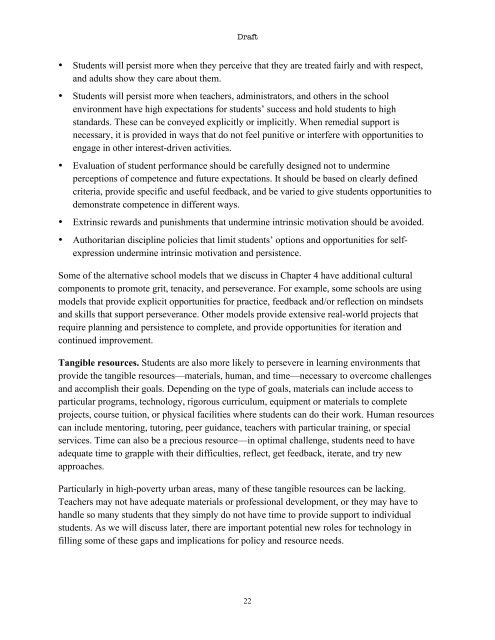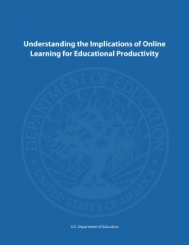Promoting Grit, Tenacity, and Perseverance - U.S. Department of ...
Promoting Grit, Tenacity, and Perseverance - U.S. Department of ...
Promoting Grit, Tenacity, and Perseverance - U.S. Department of ...
You also want an ePaper? Increase the reach of your titles
YUMPU automatically turns print PDFs into web optimized ePapers that Google loves.
Draft<br />
• Students will persist more when they perceive that they are treated fairly <strong>and</strong> with respect,<br />
<strong>and</strong> adults show they care about them.<br />
• Students will persist more when teachers, administrators, <strong>and</strong> others in the school<br />
environment have high expectations for students’ success <strong>and</strong> hold students to high<br />
st<strong>and</strong>ards. These can be conveyed explicitly or implicitly. When remedial support is<br />
necessary, it is provided in ways that do not feel punitive or interfere with opportunities to<br />
engage in other interest-driven activities.<br />
• Evaluation <strong>of</strong> student performance should be carefully designed not to undermine<br />
perceptions <strong>of</strong> competence <strong>and</strong> future expectations. It should be based on clearly defined<br />
criteria, provide specific <strong>and</strong> useful feedback, <strong>and</strong> be varied to give students opportunities to<br />
demonstrate competence in different ways.<br />
• Extrinsic rewards <strong>and</strong> punishments that undermine intrinsic motivation should be avoided.<br />
• Authoritarian discipline policies that limit students’ options <strong>and</strong> opportunities for selfexpression<br />
undermine intrinsic motivation <strong>and</strong> persistence.<br />
Some <strong>of</strong> the alternative school models that we discuss in Chapter 4 have additional cultural<br />
components to promote grit, tenacity, <strong>and</strong> perseverance. For example, some schools are using<br />
models that provide explicit opportunities for practice, feedback <strong>and</strong>/or reflection on mindsets<br />
<strong>and</strong> skills that support perseverance. Other models provide extensive real-world projects that<br />
require planning <strong>and</strong> persistence to complete, <strong>and</strong> provide opportunities for iteration <strong>and</strong><br />
continued improvement.<br />
Tangible resources. Students are also more likely to persevere in learning environments that<br />
provide the tangible resources—materials, human, <strong>and</strong> time—necessary to overcome challenges<br />
<strong>and</strong> accomplish their goals. Depending on the type <strong>of</strong> goals, materials can include access to<br />
particular programs, technology, rigorous curriculum, equipment or materials to complete<br />
projects, course tuition, or physical facilities where students can do their work. Human resources<br />
can include mentoring, tutoring, peer guidance, teachers with particular training, or special<br />
services. Time can also be a precious resource—in optimal challenge, students need to have<br />
adequate time to grapple with their difficulties, reflect, get feedback, iterate, <strong>and</strong> try new<br />
approaches.<br />
Particularly in high-poverty urban areas, many <strong>of</strong> these tangible resources can be lacking.<br />
Teachers may not have adequate materials or pr<strong>of</strong>essional development, or they may have to<br />
h<strong>and</strong>le so many students that they simply do not have time to provide support to individual<br />
students. As we will discuss later, there are important potential new roles for technology in<br />
filling some <strong>of</strong> these gaps <strong>and</strong> implications for policy <strong>and</strong> resource needs.<br />
22
















